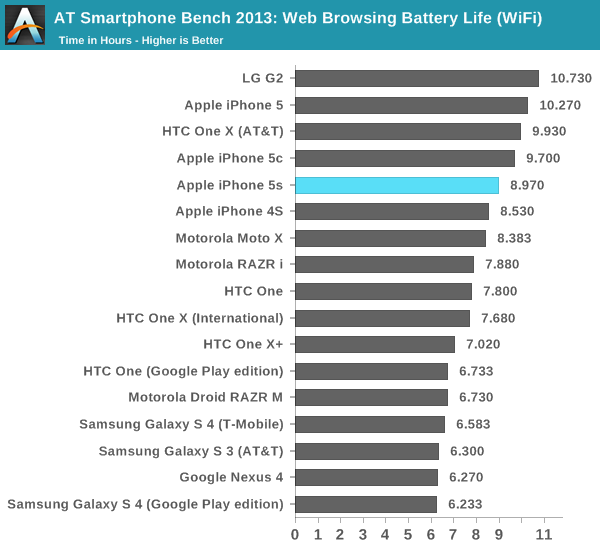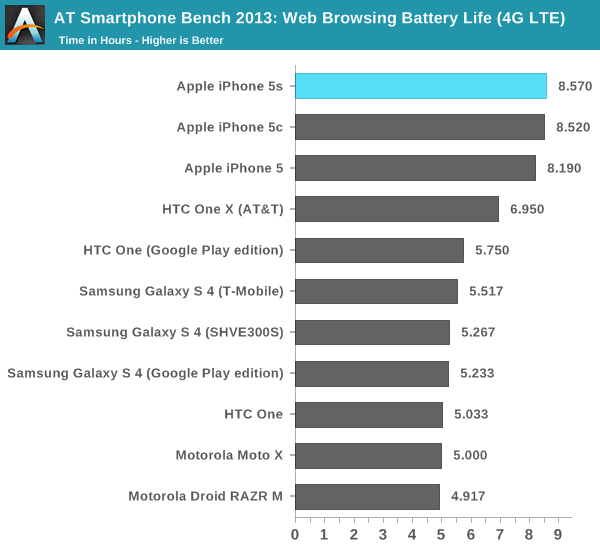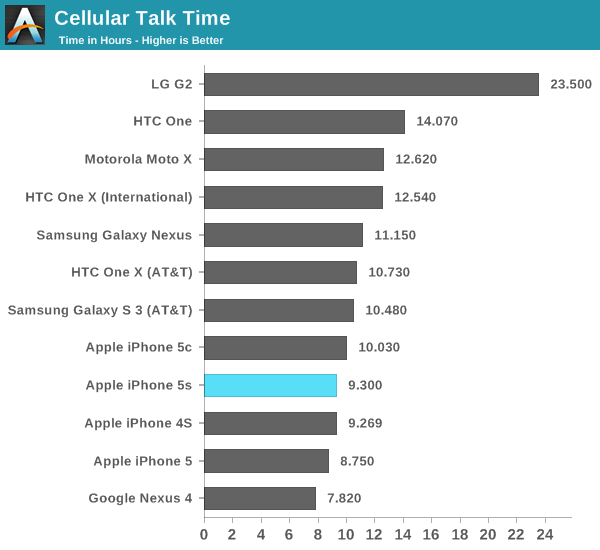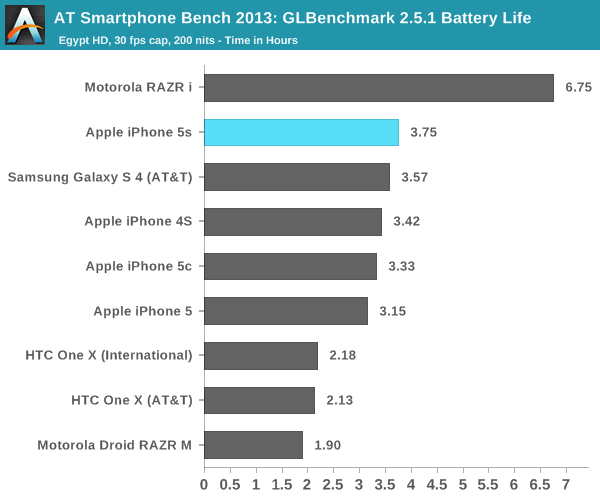The iPhone 5s Review
by Anand Lal Shimpi on September 17, 2013 9:01 PM EST- Posted in
- Smartphones
- Apple
- Mobile
- iPhone
- iPhone 5S
Battery Life
Brian did some excellent sleuthing and came across battery capacities for both the iPhone 5s and 5c in Apple’s FCC disclosures. The iPhone 5 had a 3.8V 5.45Wh battery, while the 5s boosts total capacity to 5.96Wh (an increase of 9.35%). The move to a 28nm process doesn’t come with all of the benefits of a full node shrink, and it’s likely not enough to completely offset the higher potential power draw of a much beefier SoC. Apple claims the same or better battery life on the 5s compared to the iPhone 5, in practice the answer is a bit more complicated.
Unlike previous designs, we’ve never had a half node shrink for an s-SKU. Both the iPhone 3GS and iPhone 4S stayed on the same process node as their predecessor and drove up performance. In the case of the 3GS, the performance gains outweighed their power cost, while in the case of the iPhone 4S we generally saw a regression.
The iPhone 5s improves power consumption by going to 28nm, but turns that savings into increased performance. The SoC also delivers a wider dynamic range of performance than we’ve ever seen from an Apple device. There’s as much CPU power here as the first 11-inch MacBook Air, and more GPU power than an iPad 4.
To find out the balance of power savings vs. additional performance I turned to our current battery life test suite, which we first introduced with the iPhone 5 review last year.
We'll start with our WiFi battery life test. As always, we regularly load web pages at a fixed interval until the battery dies (all displays are calibrated to 200 nits).

The iPhone 5s regresses a bit compared to the 5 in this test (~12% reduction despite the larger battery). We're loading web pages very aggressively here, likely keeping the A7 cores running at their most power hungry state. Even the 5c sees a bit of a regression compared to the 5, which makes me wonder if we're seeing some of the effects of an early iOS 7 release here.
The story on LTE is a bit different. Here we see a slight improvement in battery life compared to the iPhone 5, although the larger battery of the 5s doesn't seem to give it anything other than parity with the 5c:

Our cellular talk time test is almost entirely display and SoC independent, turning it mostly into a battery capacity test:

You can see the close grouping of the smaller iPhones at the bottom of the chart. There's a definite improvement in call time compared to the iPhone 5. We're finally up above iPhone 4S levels there.

Our Egypt HD based 3D battery life test gives us the first indication that Rogue, at least running fairly light code, can be more power efficient than the outgoing 5XT. Obviously the G6430 implemented here can run at fairly high performance levels, so I'm fully expecting peak power consumption to be worse but for more normal workloads there's no regression at all - a very good sign.










464 Comments
View All Comments
robbie rob - Sunday, September 22, 2013 - link
@justacousinNot sure whats to be said. Samsung didn't design the A7, but unfortunately for ANY company in the USA its cheaper to have most things made in asia even though they aren't designed there. Samsung fabricates many types chips and ram in its plants that it doesn't necessarily design. Unfortunately for American's this is why may products like the Xbox are made in China.
Abhip30 - Tuesday, September 24, 2013 - link
Samsung just makes them for apple.They are actually glorified foxconn. Apple provides them blueprints and samsung manufactures it. They just follow apple's instructions.Origin64 - Monday, September 23, 2013 - link
Still no HD-Ready resolution (in 2013, really?) but we have a fingerprint scanner. A shame it's hackable and fingerprints aren't safe in general, where just a few weeks ago I read about a new identification technique that made use of an infrared scan of blood vessels in your face. More unique, harder to copy. Not that that'd be good to have, the NSA will still get their fingers on those biometrics.darkcrayon - Monday, September 23, 2013 - link
Going to 720p on a 4" phone wouldn't make much difference.robbie rob - Monday, September 23, 2013 - link
Fingerprint technology is in its infancy in consumer products. Any hacking of the fingerprint scan helps Apple and the industry. Apple will be able to patch vulnerabilities found by the best of the best. My thoughts are.. Overall, no one wants my fingerprints or yours. For the millions of people out there who have an iPhone most aren't worth the work or time. To me that means I'm just fine using it to log into a phone or make a purchase on iTunes. The truth is it would be easier and more likely for someone to break into your bank account online. No one needs a fingerprint to do that.Promptneutron - Monday, September 23, 2013 - link
Another comprehensive, detailed but readable review. Anand, you produce (by some margin) the finest tech reviews on the web. Even my wife (who is a tech vacuum) read this and wants an iphone 5s..and she's not alone..;)...thank you and top work (again).NerdT - Monday, September 23, 2013 - link
All of these graphics performance comparisions (except the off-screen ones) are incorrect and absolutly miss-leading. The reason is that most of the other phones have a 1080p display which has 2.8x higher resolution that iPhone 5s! That being said, all on-screen scores will get bumped up by about the same scale for iPhone because they are calculated based on FPS only, and the frames are render the the device resolution. This is a wrong benchmarking because you are not having an apple to apple comparision. I would have expected a much higher quality report from Anandtech! Please go ahead and correct your report and prevent miss-leading information.darkcrayon - Monday, September 23, 2013 - link
As you even said, both onscreen and offscreen tests were shown, and the resolution difference was noted. They even have the iPhone 5 in the tests for the truest "apple to apple" comparison possible. I think you're grasping at straws here.robbie rob - Monday, September 23, 2013 - link
"off screen" resolutions FPS was shown ..AEdouard - Monday, September 30, 2013 - link
Hey NerdT. For a nerd, you sure don't know how to interpret charts. What do you think the offscreen tests are for? It's to eliminate the effect of display resolution. In those tests, the iPhone performed better, generally, then all other phones. The only processors that beat it where SOCs put inside tablets (where their performance can be increased).And beyond, that, isn't the main point to be able to see how the phone will perform in real life, which is why tests at the phone's resolution matter too.